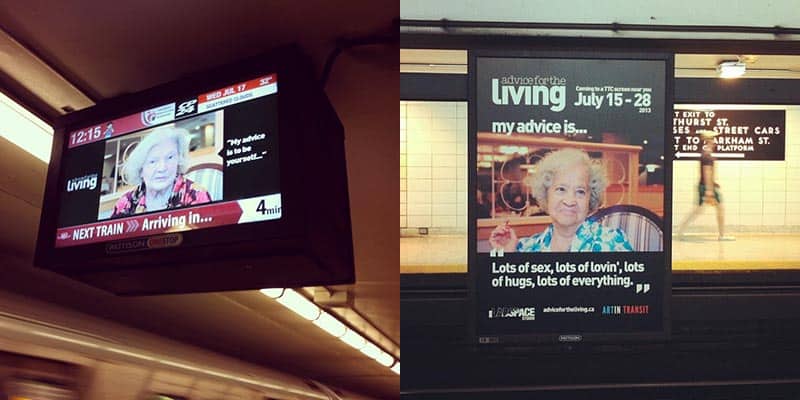If you’ve been one of the millions of TO-ers/ TO-ettes who have commuted by subway over the past couple of weeks (no exaggeration: apparently the subway ushers one million people per day around the city!), chances are you’ve encountered billboards and videos like the ones pictured here. They’re part of an installation called Advice for the Living and consist of a collection of advice clips offered by children under seven and seniors over 70. The project is an initiative from Pattison Onestop, in collaboration with LabSpace Studios; it is the brainchild of artists John Loerchner and Laura Mendes, who brought the controversial Confessions Underground to subway screens last year. We connected with Loerchner and Mendes to discuss, art, apathy, and advice for the ages.
Shedoesthecity: How did this project come about?
John Loerchner and Laura Mendes: We created Advice for the Living specifically for Pattison OneStop and Art in Transit. Last year we did a similar project for them called Confessions Underground, where we collected secrets from strangers with a portable confession booth. To our surprise, the project garnered a lot of attention and positive feedback. Lucky for us, Pattison invited us back again to do another project. Our aim this time around was to create something similar, using real content from real people, that would hopefully impact commuters on an emotional level.
As artists/curators, we’re particularly interested in exploring the messy intersections of art and everyday life. We’re always asking ourselves questions like, “How can we make our lives more artful?” and, “How can we make our art more livable or more alive?” We like creating work that people can identify with and feel a sense of connection to, rather than creating work that alienates people (as many contemporary art projects do). That’s just not our style. Not to say that our projects are intended to make people “feel good.” But certainly we want people to feel something—anything but apathy or boredom. (Apathy is the absolute worst.)
SDTC: Aside from the incredible exposure (one million people per day! That’s insane!), why stage the piece in the subway?
JL and LM: I think the subway is a perfect platform to dispense advice. For the most part, people in transit are in a rush, they’re thinking about getting to the next destination, they’re frustrated, tired, groggy. The subway isn’t the most obvious place to find enlightenment. So when we approach these kinds of projects, we look at them as opportunities to create public interventions. We ask ourselves questions like, “How can we jolt people out of their everyday?” and, “What can we do to strike a personal chord with commuters?” In our experience working on the subway, we’ve discovered that the best way to connect with the public is to create content in collaboration with the public.
SDTC: Have you been surprised with any of the advice, either specific words of wisdom or just generally amongst and between your subjects?
JL and LM: Yes! Kids are brilliant. We knew this already, but we had no idea how fully formed kids’ notions of happiness would be. Even at four years old, a child is wise enough to know that in order to be happy you have to say “kind words” and “be nice to everyone” and “spend time with mommy and daddy.” Equally surprising were the parallels and similiarities between the kids’ advice and the seniors’ advice. The most common advice from the seniors was to “spend time with your families” and “to not be afraid to do exactly what you want to do in life.” “Life’s too short.”
I think everyone’s searching for the key to happiness, but the truth is (or at least what we learned in this project) is that we already know what it takes to be happy. We know this at a very young age. But as we get older we seem to forget this.
SDTC: What was the process of advice gathering? Did people generally dispense it quite willingly?
JL and LM: We built an advice stand and took this around to different places, cities, classrooms, and seniors’ homes and just asked people the following question: “If you could give us one piece of advice on how to be happy, what would it be?” Mostly everyone was willing to offer us some kind of advice. Seniors love to talk! And kids love to get attention.
SDTC: The piece debuted on July 15. What has the reaction been like so far?
JL and LM: We’ve received nothing but positive feedback, especially from the seniors and kids involved in the project. They’re super excited to have been given the platform to voice their advice. We’ve received a number of emails and phone calls from people who have been touched by the videos they’ve encountered. We even had some guy contact us wondering if he had just seen his long lost Grandma on a TTC poster (turns out it wasn’t her but that would have been pretty cool).
SDTC: Ultimately, what do you hope people take away from the piece?
JL and LM: If anything, we’d like people to stop and think about the advice being offered and how it might apply to their own lives. Chances are, they’ve heard this advice before. But this isn’t advice form Oprah or Doctor Phil. This is the real deal. Regular people giving genuine advice to regular people.
The initiative will be running through to July 28. Until then, make sure you look around while you’re underground. You may just get some good advice.




 Follow Us On Instagram
Follow Us On Instagram
